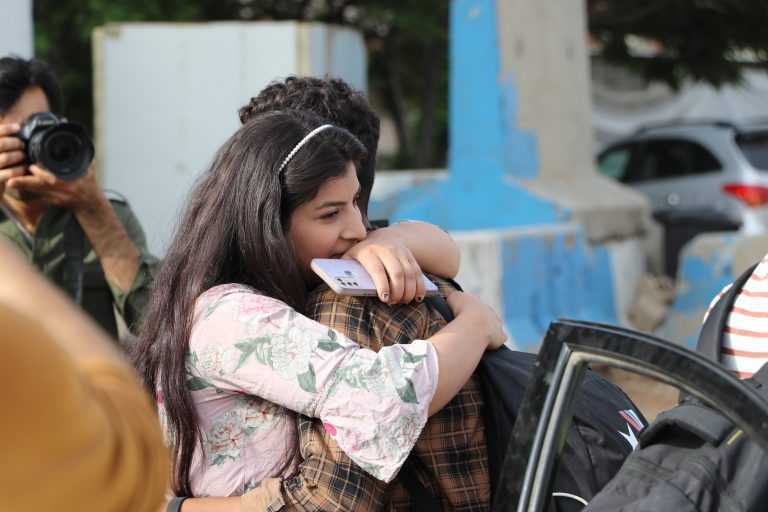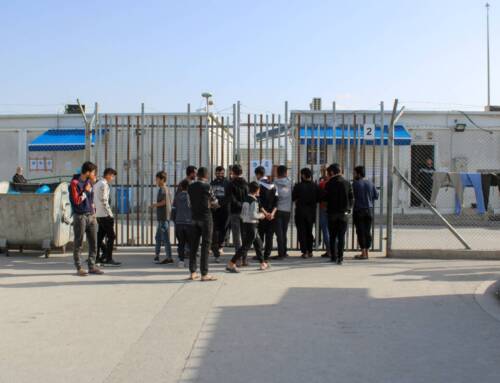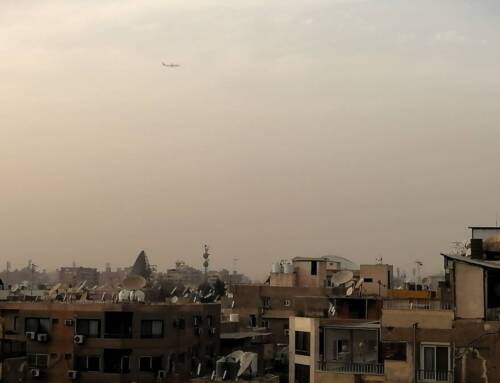‘We want to send them home, not to the security branches’: Tensions between AANES, regime stall Sudan repatriations
Sudan hosted around 100,000 Syrians before war broke out in April. Northeastern Syria’s Autonomous Administration has repatriated hundreds of them, but tensions with Damascus stalled the process.
15 June 2023
QAMISHLI, ERBIL — In a steady voice loaded with emotion, Umm Roslin recalled the last days she spent in Sudan, the country she has called home for the past 14 years and where she gave birth to her five children.
“At first, we didn’t think of leaving our house,” Um Roslin told Syria Direct by phone from northeastern Syria, asking for her full name to be withheld due to concerns for the safety of her husband, who is still in Sudan. “We expected the situation would settle down after a few days, as it usually does here when political problems happen. But when our Sudanese neighbors left and there were only two Syrian families left in our building, fear crept into my heart.”
Umm Roslin has lived in Sudan since 2009, along with her husband and five children, who all have Sudanese citizenship. But on April 15, clashes erupted between opposing factions within the country’s military government. By late April, violence spiraled out of control in the family’s neighborhood in the Sudanese capital, Khartoum, and they had to flee.
As of mid-June, the conflict in Sudan has already displaced more than 1.9 million people, according to the United Nations—including thousands of Syrians, many of whom sought refuge in Sudan to escape their own civil war.
Umm Roslin considers herself lucky. She and her children were among a few hundred people evacuated by plane from Sudan on May 22, while the majority of Syrians in the country had to find their own way out.
She left on one of three evacuation flights organized between members of the Syrian diaspora in Sudan and the Autonomous Administration of North and East Syria (AANES)—the de facto entity controlling northeastern Syria—in coordination with the Syrian government. Damascus still controls all civilian airports in northeastern Syria, despite having lost territorial control over most of the region.
This uneasy cooperation allowed more than 350 Syrians to evacuate to safety, but thousands of others remain stranded. Some are not from northeastern Syria and are therefore not eligible for the flights, while others are wanted by Damascus’ security services and cannot risk passing through regime-held airports. And since the end of May, tensions between the AANES and the regime have halted additional flights.
‘Incredible scenes of violence’
Sudan has endured several waves of instability in recent years. From 2011 to 2013, the country was rocked by protests calling for the fall of autocrat Omar al-Bashir, who had ruled the country with an iron fist since 1989.
The peaceful protests, which were violently suppressed, did not succeed at first in toppling al-Bashir. But they resumed with greater force in 2018, and in 2019, al-Bashir was ousted from power by a coup amidst rising popular pressure against his regime. But the army-led coup paved the way for more instability and renewed civilian protests as generals clung to power, derailing the transition to democracy.
Still, Umm Roslin was not prepared for the outburst of violence on April 15, when the Rapid Support Forces (RSF), a powerful paramilitary group, started fighting the Sudanese army. Khartoum woke up to gunfire and the sound of fighter jets flying over the city.
“We are used to political problems happening in Sudan, but these were usually temporary—lasting for hours or a few days,” she explained. “This time, we witnessed incredible scenes of violence: gangs of young men flooding the streets, carrying knives and iron bars, ready to brutalize people. Many families who tried to leave Sudan were attacked by these gangs, but thankfully we were spared.”
Many of those who were in the capital when the fighting began reported acts of violence carried out by the forces vying for control of the city, from large-scale looting and extortion to widespread sexual violence.
But cowering indoors and waiting for calm to return was not an option. Quickly, food and water ran out. “From the very first days, basic services stopped. Our neighbors left because the water was cut off, and every day, the situation got worse. We heard shooting very close to the house,” Umm Roslin recalled.
A chaotic escape
Along with several other families from their neighborhood, Umm Roslin’s family fled to Shendi, a city 160 kilometers north of Khartoum. For a month, they shared an overcrowded shelter with six or seven other families. “Women and children slept together in one room, 37 people in total,” Umm Roslin said. “Men stayed in another.”
As fighting between the warring factions intensified over the following days, hundreds of thousands of Sudanese citizens and foreign residents headed north, trying to cross the land border to neighboring Egypt. Others headed to Port Sudan, a city on the Red Sea, to embark on repatriation ships sent by Gulf countries. But Umm Roslin’s journey was different. Unlike most Syrians, who were left entirely on their own to face the chaos, her family got help from the AANES to evacuate to northeastern Syria.
“I received a call from my nephew, who was in touch with coordinators from the AANES, asking me to register our names and the names of all the families who wanted to leave for northeastern Syria,” she recalled. “They told us the flight would be on Friday, but then it was postponed to Saturday, and then we didn’t hear anything. Finally my nephew called me on Saturday at noon, and he told me the plane would leave in the evening.”
They left immediately, racing to cover the 500 kilometers that separated them from Port Sudan, and safely reached the northeastern Syrian city of Qamishli the following day.
Those who stayed behind
Umm Roslin’s family is originally from Kobani, a predominantly Kurdish city in northeastern Syria controlled by the AANES. But had they been from another part of Syria, one controlled either by the Syrian regime or opposition factions, they would not have been eligible for the flight, which was organized and paid for by the AANES.
“We evacuate all Syrian citizens who are from north and east Syria, without distinction,” Welat Kute, a member of the Syrian diaspora in Sudan who helped coordinate the flights, told Syria Direct. He requested to use a pseudonym as he is still in Sudan. “It’s not just Syrian Kurds, we are evacuating everyone indiscriminately—people from Kobani, Tal Abyad, Raqqa, Deir e-Zor and Manbij.”
But even among those who are from northeastern Syria, some could not board the flight. It would have been riskier for them than staying in Sudan or finding another way out, because flying back to Syria meant passing through airports and security points controlled by the Syrian regime.
“From the very beginning, we told Cham Wings—which operated the flights—there might be issues with people who are wanted by the regime,” Kute said. “At first they told us it wouldn’t be a problem, but eventually they told us that we should check whether some of the passengers are wanted by any branch of the regime, because they couldn’t protect anyone who is wanted.”
Cham Wings, Syria’s first private airline, was placed under United States sanctions in 2016 for transporting weapons and fighters for the Syrian regime, as well as laundering money on its behalf.
So far, the AANES has organized two flights from Port Sudan to Qamishli with Cham Wings. The first, on May 22, carried around 150 passengers, according to the AANES’ Department of External Relations. The second flight left on May 31 and carried 170 passengers, not counting babies and young children.
Another flight on May 28 repatriated the bodies of three Syrian Kurds killed in a car accident while fleeing Sudan, as well as 21 passengers, including relatives of the deceased. But unlike the other two, that flight landed in Damascus.
Since the end of May, the AANES’ repatriation scheme appears to have broken down due to disagreements between the two entities.
“At the end of May, we were told that Damascus has reservations regarding these repatriation flights, and we received a message saying that those repatriated from Sudan are only allowed to land in Damascus,” Kamal Akef, the spokesperson of the Department of External Relations of the AANES, told Syria Direct.
According to members of the Syrian diaspora in Sudan, there are still “hundreds” of Syrian families in Sudan waiting for an evacuation flight to northeastern Syria. More are likely stranded in Egypt, where most people who fled the country have taken refuge.
Between March and the beginning of May, the UN’s refugee agency UNHCR registered 365 new Syrian refugees in Egypt, for a total of 146,995 Syrian refugees in the country. However, due to the recent nature of the crisis and the fact that many refugees don’t register with UNHCR, total arrivals of Syrian refugees to Egypt are likely higher.
“We are in touch with families who are still in Sudan,” Umm Roslin said. This includes her husband, who stayed behind to watch over their properties in Khartoum. “They tell me that they lack medicine and milk, and that there are no doctors. Only one Sudanese family remains in our former building. They struggle to find flour, sugar and many staples in the market, and what they do find is overpriced.”
From heaven to hell
Before the current war, Sudan was home to a thriving Syrian diaspora. Until December 2020, Syrians could travel there without applying for a visa. They had the right to work and study, and could obtain citizenship after living there for five years.
Because Sudan was relatively welcoming, thousands of Syrians sought refuge in Sudan after 2012, many of them fleeing persecution by the Syrian regime. By 2021, around 100,000 Syrians lived in Sudan, according to official figures.
Some, like Kute and Umm Roslin’s family, moved there before 2011 for economic reasons, opening restaurants, cafés and construction businesses. “My husband moved to Sudan long before the Syrian crisis began. Opportunities were better in Sudan than in northeast Syria,” Um Roslin said.
Others fled primarily to live in a safer country, but the promised haven has since turned into an inferno—one that is difficult to escape.
“The flights have been suspended because the Syrian regime is pressuring Cham Wings to drop the passengers in Damascus instead of taking them directly to Qamishli [in northeastern Syria],” Kute said. “How can we guarantee the safety of these families, and how can we ensure they won’t be harassed or arrested? We want to send them home, not to the security branches of the Syrian regime.”
*This report was updated on June 15, 2023 to include a statement from the AANES’ Department of External Relations and update the information presented in the report. A previous version incorrectly stated that all three repatriation flights landed in Qamishli.







